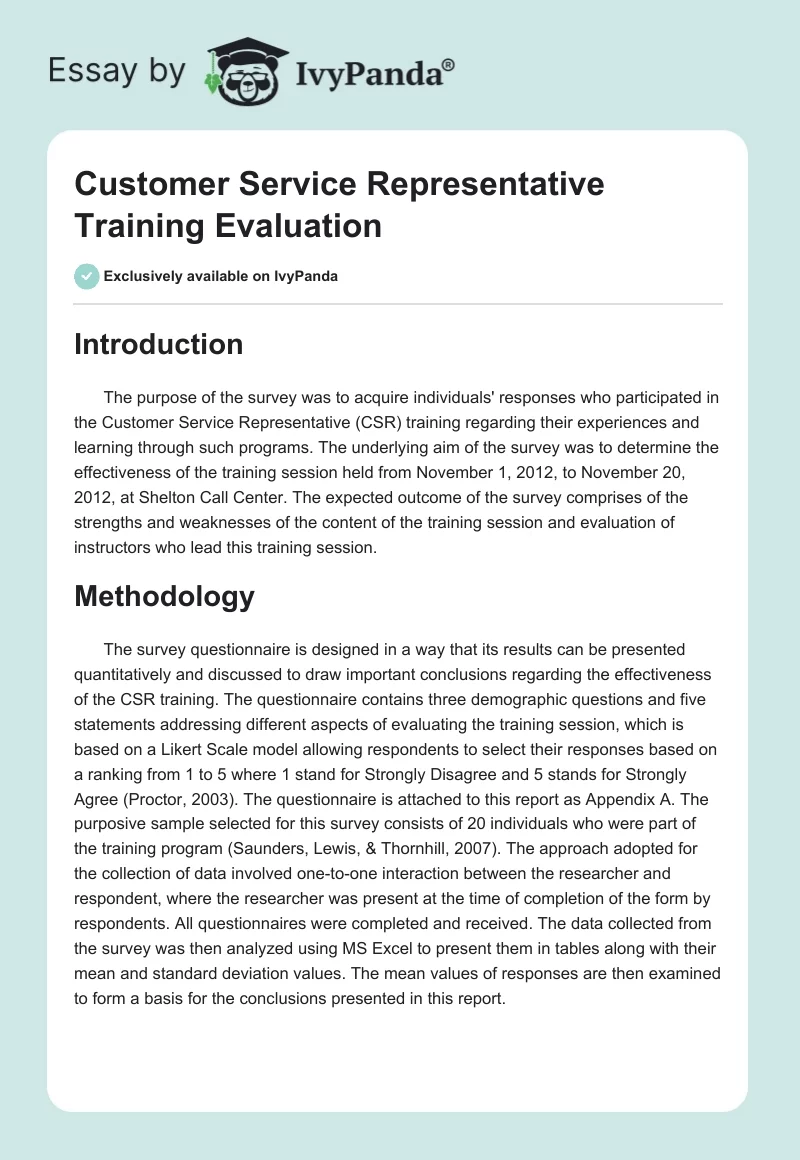Introduction
The purpose of the survey was to acquire individuals’ responses who participated in the Customer Service Representative (CSR) training regarding their experiences and learning through such programs. The underlying aim of the survey was to determine the effectiveness of the training session held from November 1, 2012, to November 20, 2012, at Shelton Call Center. The expected outcome of the survey comprises of the strengths and weaknesses of the content of the training session and evaluation of instructors who lead this training session.
Methodology
The survey questionnaire is designed in a way that its results can be presented quantitatively and discussed to draw important conclusions regarding the effectiveness of the CSR training. The questionnaire contains three demographic questions and five statements addressing different aspects of evaluating the training session, which is based on a Likert Scale model allowing respondents to select their responses based on a ranking from 1 to 5 where 1 stand for Strongly Disagree and 5 stands for Strongly Agree (Proctor, 2003). The questionnaire is attached to this report as Appendix A. The purposive sample selected for this survey consists of 20 individuals who were part of the training program (Saunders, Lewis, & Thornhill, 2007). The approach adopted for the collection of data involved one-to-one interaction between the researcher and respondent, where the researcher was present at the time of completion of the form by respondents. All questionnaires were completed and received. The data collected from the survey was then analyzed using MS Excel to present them in tables along with their mean and standard deviation values. The mean values of responses are then examined to form a basis for the conclusions presented in this report.
Results
Demographics
The results show that 17 individuals who underwent training sessions and also took part in the survey are female and 3 individuals are male. The age profile of respondents is summarized in the following table which indicates that the majority of respondents belong to the age group of 22-25 years.

Assessment of Training Program
In this section, five statements were included to address the assessment of different elements of training. The results from the survey are summarized and presented in the following.

The table above indicates that most of the respondents do not feel high about the training that they received as the mean values of all statements included in the questionnaire are between 2 and 3 or just above 3. This is not a positive sign for the organizers of the training session as it is important for the organization conducting the training session that the respondents can benefit from it and become an important part of the team. In particular, the statement that examines whether the content of the training session is comprehensive got the weakest reply from the respondents.
Implications
There are clear implications of the survey for the organization conducting the training session and it must address weaknesses in the program to ensure that attendees can feel strong about its positive outcome. Otherwise, this could create problems for the company and it may not be able to serve its customers well, and thus, its services ay yield poor financial results for the company (Yang & Peterson, 2004). This also suggests that the organization must employ trainers who have a strong background, knowledge, and ability to train individuals.
Reference List
Proctor, T. (2003). Essentials of Marketing Research. New York: Prentice Hall.
Saunders, M., Lewis, P., & Thornhill, A. (2007). Research Methods for Business Students. New York: Pearson Education.
Yang, Z., & Peterson, R. T. (2004). Customer Perceived Value, Satisfaction, and Loyalty: The Role of Switching Costs. Psychology & Marketing, 21(10), 799–822.


